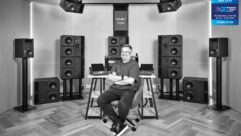Grasping the fundamentals
Apr 1, 1999 12:00 PM,
Drew Daniels
Transducers are not magical or mystical, though one might think so afterbeing exposed to sufficient loudspeaker marketing. The depth ofunderstanding about transducers is shallow, owing in large part to the lackof exposure most Americans get to schooling in physics and other sciences.This leaves many people with inadequate defenses against those who useignorance to prey upon consumers. Two examples are loudspeakers that lay ontheir sides with the woofers and tweeters horizontally spaced apart andloudspeaker wire priced at $1,000/ft. There are many more, but this articlewill focus on the narrower topic of what a typical loudspeaker transduceris and how it functions, so that after review, you will be able todisregard the marketing hype and see the essential quality of thetransducer elements you purchase and use.
Loudspeakers are transducers that convert electrical energy to acousticenergy. Acoustic energy, in the strictest definition, is a mechanicalvibratory motion of matter propagating through matter as waves. Acousticenergy may consist of one or two types of mechanical waves. Transversewaves have the motional characteristic of musical instrument strings, suchas the slow, easily visible wave that propagates along a rope when one endis wagged or the ripples on the surface of a still pond when an object isdropped into the water. Longitudinal waves are those characterized by theend-to-end waves of the air column developed along the pipe of a horn. Itis sometimes possible to see a longitudinal wave propagating along a floppystretched spring, but longitudinal waves generally move too fast to be seen.
Sound that we hear is made by longitudinal waves moving through open air.These waves vary in air pressure, density and to a small extent,temperature. Waves begin at a source and spread out spherically; thenatural shape of a large wave emanating from a small source is always asphere. This natural tendency can be visualized if we imagine the air as amedium in which changes in air pressure are being evened out. Given norestraint, the pressure will flow in every direction equally where thedensity and pressure of the air is equal. A static analogy of thisphenomenon is easily imagined using water poured into a pan already filledhalf way with water. Rather than forming a rising mound of water as newmaterial is poured in, the surface pressure propagates throughout the panequally until gravity has smoothed out the surface and brought the entirevolume of material to equilibrium at dead-level.
Loudspeakers work by moving air, or more precisely, by disturbing the airfrom its normal static location. Airbornesound, as stated before, isvibrating air molecules, but this definition bears some examination. It isnot necessary for air to blow or move to make sound, although blow it does,mostly near loudspeaker cones and loudspeaker vent ports. It is possiblefor waves to move through still air because of air’s elasticity; you mightpicture each air molecule loosely attached to its neighbors in alldirections by tiny springs. Thus, when a molecule is given a shove, itpasses the energy on-through its springs-to the molecules around it. Thisis the essence of longitudinal soundwave motion, the phenomenon that makesit possible for a loudspeaker to shove air and produce a wave that travelsoutward from the cone and through the air medium in a longitudinal motionaway from the cone.
Perception of sound starts with the vibration of air molecules pushingagainst our eardrums. It does not take much pushing for us to hear; infact, at 4 kHz, most people can hear sound when the eardrum motion is aboutequal to the distance across the diameter of a hydrogen molecule (Figure1). Displacement amplitude of air molecules depends on the frequency of thesound (Table 1).
Air-molecule motion in a spherically spreading wave decreases in amplitudeas the square of the distance from the stimulus source (1/4 the amount ofthe motion as distance doubles). The motion itself gets pretty small by thetime we get as far away as a typical listener. In unit terms, one acousticmilliwatt per square centimeter (0.001 W/cm2 or somewhere near the totalarea of both your eardrums) is enough to cause physical pain in the earsand some permanent hearing loss.
That may not sound like a lot of power, but it is approximately 130 dB orso, and loudspeakers are not terribly efficient. Loudspeaker transducerefficiency is a measure of the output of acoustical energy versus the inputof electrical energy. When a specification tells us that a givenloudspeaker device is 3% efficient, it means that if we feed theloudspeaker 100 W of electrical energy, it should produce 3 W of acousticalenergy as output. The maximum efficiency achievable by a loudspeaker ishalf the electrical input power, or to put it another way, 1 W in, 0.5 Wout.
Typical loudspeaker transducer efficiency ranges from 0.2% to 5% forcone-type transducers and 15% to 45% for compression driver-typetransducers (horn driver). This is because of a trick nature plays on uscalled radiation resistance, which boils down to the inability of aloudspeaker cone or diaphragm made of a solid (hard substance) to transferenergy to a soft substance (gas). The energy transfer from solid to gasmust take place through a gross mechanical impedance mismatch.
Magnetism, electromagnetism and motorsElectromagnetism is the magnetism resulting from the application ofelectricity to wires or other electrical conductors. When electric currentflows in a wire, a magnetic field is created around the wire. The nature ofthe magnetic field created follows the right-hand rule to label thedirection of the current flow through the wire and the magnetic fieldgeometric orientation. By making a fist with your right hand around thewire and pointing the thumb in the direction of current flow (pictured aspositive flowing toward negative), the field twists around the wire in thedirection that the fingers point. Magnetic-field orientation (N-Salignment) around the wire is perpendicular to the flow of current. Thefield also curls around the wire, revolving back onto itself. For astraight segment of wire, the magnetic field forms a cylinder; for a loopof wire, the field forms a toroid. In a coil of wire, the magnetic fieldstrength is multiplied directly by the number of turns. Magnetic fieldvariations near a wire cause currents to flow in the wire that areproportional to the rate of change of the magnetic field strength (flux).
Flux is the strength of a magnet or magnetic field-producing means. Thisdefinition applies to the total of the magnetism available in the magnet ormagnetic field-producing device. Flux density, onthe other hand, is thelocal magnetic field intensity. This term applies to the magnetic fieldnear the business end of the magnetic device, such as the air gap in aloudspeaker magnet where the loudspeaker’s voice coil resides. The totalflux and the flux density can appear to be quite independent from oneanother; for example, a ferrite loudspeaker magnet slab may measure only0.2 T to 0.35 T (teslas, see SI definitions) on its surface, but with ironpole pieces to collect and concentrate the total flux in the slab, the fluxdensity or field intensity in a small air gap between two pieces of ironcan be focused to produce a field strength as high as 1.8 T-the maximumdetermined by the magnetic permeability (field-carrying ability) of iron.
Here are a few other relevant definitions. The pole is the end or terminusof a magnet defining its magnetic field maximum. The pole piece is amagnetic-conducting steel or iron plate or ring used to conduct andconcentrate magnetism from a magnetic material to an air gap. Finally, atransducer is a device that converts energy from one form to another.Examples include the light bulb (electricity to heat and light), electricmotor (electricity to rotational motion), mic (sound to electricity),battery (chemical reaction to electricity), car engine (chemical reactionto motion and heat) and solar cells (light to electricity).
Loudspeakers convert electricity to the alternating-direction linear motionof the voice coil, resulting in cone vibration and ultimately resulting insound. Dynamic mics work in exactly the opposite way. In fact, manyheadphone transducers can demonstrate mic-like behavior when plugged intoan audio mixer’s input, and most dynamic mics could be used as (low-power)earphones in a pinch.
Loudspeakers are not limited to linear reciprocal motion by anything intheir nature. In fact, a totally rotational loudspeaker exists wherein therotational motion of an electric motor is used to wag a vane inside anaxially ported cylinder to push air back and forth. From the standpoint ofsimplicity and economy, however, nothing has ever bested the familiarcone-style loudspeaker using a voice coil glued directly to thesound-producing cone. It needs no gears, slides or bearings, only someself-centering compliance rings to hold the cone so that the voice coilremains centered in the air gap.
In the cross-section shown in Figure 2, the magnetic field flux isconcentrated in the air gap. The magnetic field crosses the air gaphorizontally so that it is oriented parallel to the voice coil (all the wayaround the coil). Thus, when a current passes through the coil, theresulting magnetic field-at a right angle to the stationary field-pushes torepel or pulls to attract the stationary field, producing motion at a rightangle to the permanent magnet’s field direction. Given typically high fieldstrength and a sufficient number of turns of wire in the air gap, push-pullforce as high as 22 newtons per ampere is common in modern high-powerloudspeakers. As you might imagine, this challenging set of conditions hascreated a large new market segment in adhesive compounds.
On Table 2, Table 3 and Table 4, you are given the units of measure andtheir definitions. The charts are not complete, but they do contain thoseunits required to examine loudspeaker transducers. Once you have the units,you can calculate the expected results. Indeed, this is how transducerengineers design transducers-starting with a model and plugging in numbersto obtain an expected result.
In 1960, the international General Conference on Weights and Measures metin Paris and named the Metric System of units (based on the meter,kilogram, second, ampere, kelvin and candela) the “International System ofUnits.” The international General Conference on Weights and Measuresestablished the abbreviation “SI” as the official abbreviation, to be usedin all languages (not S.I.). SI units are used to derive units ofmeasurement for all physical quantities and phenomena. There are seven SIbase units, from which mostother units are derived.
Definitaions of SI unitsThe following list is provided to allow correspondence between magnetic andelectrical quantities. The wording used by the Conference may seem stilted,but it is carefully chosen for semantic clarity to make the definitionsunambiguous.
The ampere is that constant current which, if maintained in two straightparallel conductors of infinite length, of negligible circular crosssection, and placed 1 m apart in a vacuum, would produce between theseconductors a force equal to 2 x 10-7 N/m.
The coulomb is the quantity of electricity transported in 1 second by thecurrent of 1 A.
The farad is the capacitance of a capacitor between the plates of whichthere appears a difference of potential of 1 V when it is charged by aquantity of electricity equal to 1 coulomb (C).
The henry is the inductance of a closed circuit in which an electromotiveforce of 1 V is produced when the electric current in the circuit variesuniformly at a rate of 1 ampere per second.
The joule is the work done when the point of application of 1 N isdisplaced a distance of 1 m in the direction of the force.
The kilogram is the unit of mass; it is equal to the mass of theinternational prototype of the kilogram. The international prototype of thekilogram is a particular cylinder of platinum-iridium alloy preserved in avault at Sevres, France, by the International Bureau of Weights andMeasures.
The meter is the length equal to 1,650,763.73 wavelengths in vacuum of theradiation corresponding to the transition between the levels 2p10 and 5d5of the krypton-86 atom.
The newton is that force which gives to a mass of 1 kg an acceleration of 1meter/second2.
The ohm is the electric resistance between two points of a conductor when aconstant difference of potential of 1 V, applied between these two points,produces in this conductor a current of 1 A, this conductor not being thesource of any electromotive force.
The second is the duration of 9,192,631,770 periods of the radiationcorresponding to the transition between the two hyperfine levels of theground state of the cesium-133 atom.
The volt is the difference of electric potential between two points of aconducting wire carrying a constant current of 1 A, when the powerdissipated between these points is equal to 1 W.
The watt is the power which gives rise to the production of energy at therate of 1 joule per second.
The weber is the magnetic flux which, linking a circuit of one turn,produces in it an electromotive force of 1 V as it is reduced to zero at auniform rate in 1 second.
Transducer theory, as it applies to loudspeakers, is not difficult tograsp. In taking that integral first step in understanding the physics ofthe loudspeaker, however, you will go a long way to improving the level ofservice you can provide your clients. A little knowledge is all that isneeded to cut through the myths.










